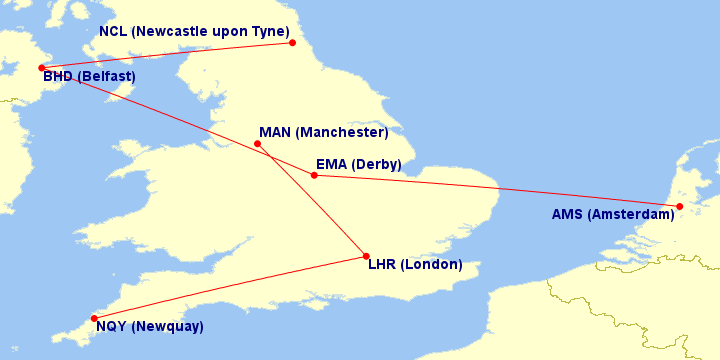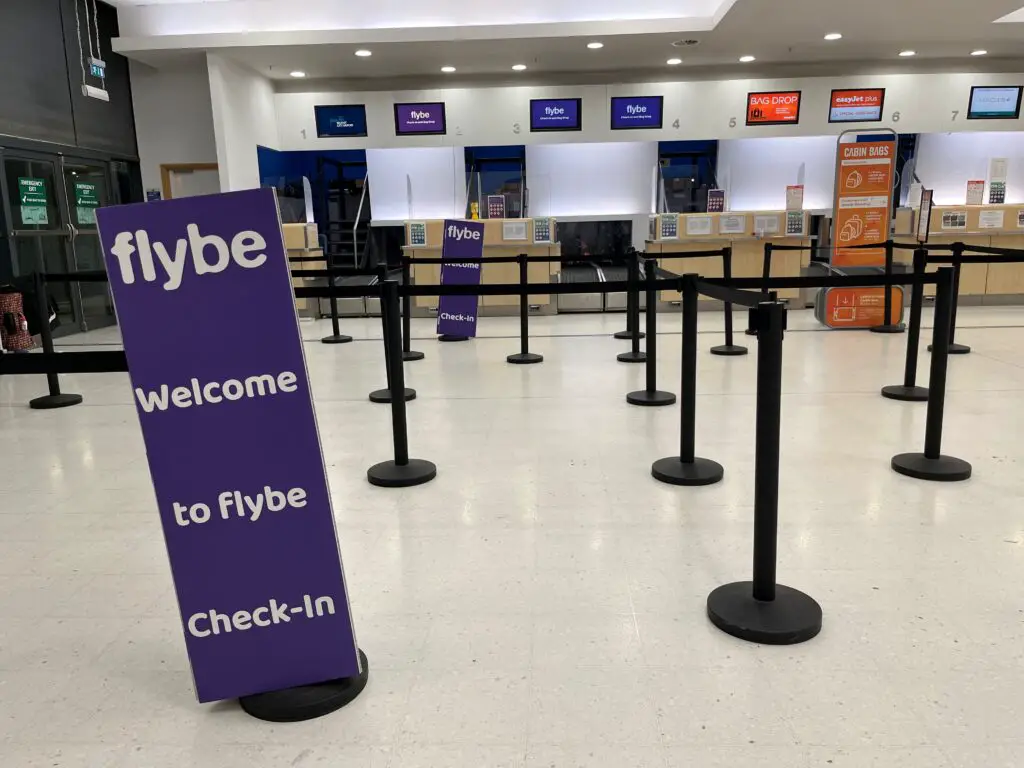Disappointment, but not surprise, filled the British aviation market today as, once again, shareholders decided to pull the plug on the second iteration of flybe — which once upon a time was Britain’s largest regional airline.
The news was broken very early in the morning, before any of the airline’s flights could take off this Saturday. An announcement in the airline’s website and social media reported the appointment of the new Joint Administrators, as mandated by the English High Court.
On 28 Jan 23 David Pike & Mike Pink were appointed Joint Administrators of Flybe Limited. Flybe has now ceased trading. All Flybe flights from & to the UK are cancelled & will not be rescheduled. Further information can be found @ https://t.co/VbCQW2SmGn & https://t.co/bcNJz3Cthq pic.twitter.com/DhLb8UhwXk
— Flybe ✈ (@flybe) January 28, 2023
The regional airline had restarted its operations less than a year ago, in April 2022. Technically, it was not the same flybe that went under in 2020, but it took assets from that one, including the brand and slots in constrained airports. It also had a common shareholder, Cyrus Capital, a hedge fund focused on distressed investment, who took up the remains of flybe after its first demise.
Smaller scale, higher competitive pressure
Something the new owners tried to change slightly, however, was the airline’s business focus. While before shutting down in early 2020, the «first» flybe had a more complex fleet with both Embraer jets and De Havilland Dash 8-400 turboprops, this one only had the propeller aircraft.
At the time of its demise this Saturday, according to Planespotters.net, the airline operated nine Dash 8s — a far cry from the March 2020 number of over 50 Dashes. But the «new» airline’s problem was not the smaller scale; even the network it had picked was radically different from two years prior.
After the demise of Stobart Air later in 2020, Aer Lingus picked a new regional partner in 2021, Emerald Airlines, to operate under its Aer Lingus Regional franchise.
With a leaner structure and good availability of ATR aircraft in the market, Emerald took the opportunity and opened an important base in Belfast City Airport, one of flybe’s five most important markets until 2020.
Belfast City Airport, as we discussed later last year when flying the new flybe, is the corporate’s favorite airport in the city, largely because it’s closer to downtown than Belfast International.
As such, while flybe operated alone in all twelve routes it operated from Belfast City on December 2019, according to data by Cirium’s Diio Mi application, on December 2022 it saw competition in six out of nine.
But the increased challenge was not only in the central airport — now low-cost pressure was greater from the farther airport, too. From Belfast International, easyJet served four of the twelve destinations flybe connected from City in December 2019. It was a different game in the same month of 2022, as the British low-cost carrier served all nine but Heathrow, where easyJet doesn’t fly to.
In total, the new flybe only served five routes on its own (seen below), although some of East Midlands’ catchment area overlaps with that of Birmingham Airport.

«Unsustainable operations by other airlines»
Another competitor that took several opportunities left by flybe in 2020, once the pandemic restrictions allowed, was Loganair. Of the major markets in Britain where it has grown expressively from December 2019 to December 2022, according to Cirium, many were previously operated by the first «version» of the former.
The Glasgow-based airline — which happens to be Britain’s largest regional carrier now — has taken the pandemic opportunity to start a fleet transition from its older fleet of Saab 340s to the more modern and cost-competitive ATR 42 and 72s (it has also kept most of its Embraer ERJ fleet, too).
Take the example of the Aberdeen, Isle of Man and Southampton markets. Of the 14 routes that were not operated in the last month of 2019 but were flown in the same period of 2022, nine were «inherited» from flybe. Particularly from the Isle of Man, where it barely had any flights, or Southampton, which it did not serve at all, Loganair took the post-pandemic void to grow expressively in such cities.
Loganair, indeed, was a long and open critic of flybe’s revival. The first time this appeared in the media was back in August, when it decided to drop out of Cornwall Airport in Newquay for this Winter.
The decision, according to their CEO Jonathan Hinkles, was because of «the airport management’s decision to incentivize unsustainable operations by other airlines», referring to flybe’s planned flights into Cornwall, and particularly their flights to London/Heathrow.
«I believe the airport’s decisions are as short-sighted as they are short-termist, and will have genuinely adverse consequences for Cornwall’s year-round air connectivity», said Hinkles back then. «For a start, it’s absolutely crackers to incentivize a new air service that will compete head-on with a route that the airport’s own sole shareholder – Cornwall Council – subsidizes another airline to fly [Eastern Airways to Gatwick, ed.] under a PSO mechanism. How can that be a sensible use of taxpayer funds for Cornwall, or the UK more broadly?».
Loganair connected Newquay to Edinburgh, Manchester and Newcastle. After the news this weekend, it said it will restart the flight to Manchester on February 10.
What went wrong?
In a press release, Joint Administrator David Pike from Interpath Advisory broke down the demise of flybe’s second coming.
«Unfortunately, the company had to withstand a number of shocks since its relaunch, not least of which was the late delivery of 17 aircraft which it needed for its schedule, and which has severely compromised both the airline’s capacity and its ability to remain competitive. This has driven significant financial losses and an associated cash drain for the business.»
Late deliveries were a constant complaint by the airline, justifying their ever-changing schedules — but Pike’s statement also suggested that there was also no further interest of the airline’s owners to keep funding the company.
«Over the past few months, enormous efforts have been undertaken by the directors and key stakeholders to safeguard the future of the business, including undertaking a process to seek new investors and/or owners. Unfortunately, with the aviation sector still adjusting to the ‘new normal’ following the pandemic, it appears the time was not right for this process to reach a successful conclusion.»
«Having ultimately exhausted its available capital base, and with no alternative options available, the directors have taken the difficult decision to place the Company into administration.»
The slots question
But the Administrators still believe flybe can be passed forward. As Pike mentioned in the press release, «we do intend to preserve scaled-back elements of the operating platform for a short period such that a rescue transaction remains a possibility. Should any interested party want to explore reviving the airline, I’d encourage them to come forward and make contact with the utmost urgency.»
While flybe’s fleet is entirely leased, the airline does have very valuable assets: the slots it inherited upon its startup, particularly in Amsterdam and in London/Heathrow.

According to Cirium, in December last year the airline operated five rotations to Amsterdam on weekdays and Sundays, with three daily flights on Saturdays. Meanwhile, Heathrow saw seven weekday rotations, three on Saturdays and five on Sundays.
An article by the Financial Times quoting Pike remarks that these assets can not be sold on their own — thus, for one airline to pick up these slots, it would have to buy what remains of flybe, or at least the «UK business and/or the Amsterdam business».
This alone makes one think — and an industry consultant quoted by the Financial Times makes a similar claim — if this new flybe wasn’t just a way for the shareholder (which remember, is a distressed investment-focused fund) to hold on to the gold-valued slots and then try to sell it at a profit.
That, unless flybe found it a good idea to connect Heathrow to Amsterdam twice daily with turboprops, going against British Airways and KLM in their largest markets.
flybe won’t tear us apart, again
As mentioned by the Joint Administration, the clock is ticking to sell what ever remains of flybe’s second failure.
But, once again, flybe leaves a negative mark on customers but especially on its employees, who must have woken up to the news.
As Loganair’s CEO Hinkles said in a brief message to the media, «I feel so terribly sad for a team of folks who, just like our own, put on their uniforms at all manner of unsociable hours, went to work and tried their very best. It’s not through their efforts or any lack of them that this day has dawned – and right at the toughest time of year too. Yet it’s a reminder, if any were needed, of just how difficult this industry can be.»
We had the opportunity to fly three regional airlines from the British Isles late in 2022 — Emerald Airlines, flybe and Loganair. The Emerald crew, which was based in Belfast City, had previously worked at flybe, and they were just so glad they were given their wings again. And I bet many of the employees at the «new» flybe had come from the same origin.
Hinkles said «today’s collapse had an air of sad but certain inevitability about it right from the outset – it was a poor plan, and its delivery of that plan has been beset by almost every conceivable issue, many of which were self-inflicted. My heart goes out to the crews and engineers who had re-joined in the hope that this would be so different.»
So, will anyone miss flybe? Of course, in the short term, its workers — and the 75,000 passengers who had their flights cancelled, according to the BBC — will.
However, I would say not so much from a customer perspective. Competitors took over its remains quite quickly after the first time it went bust. Now Belfast City is very well served by Emerald Airlines; Belfast International also has a larger domestic low-cost carrier presence; and so does Birmingham, where easyJet competed in all routes the «second» flybe served.
That is to say, of course customers might be furious or sad now, but pretty soon they will find reliable, cheaper alternatives to the «new» flybe, which barely served any routes alone anyway.
If the shock was quite expressive when flybe first went bust back in March 2020, not it won’t be that much.














